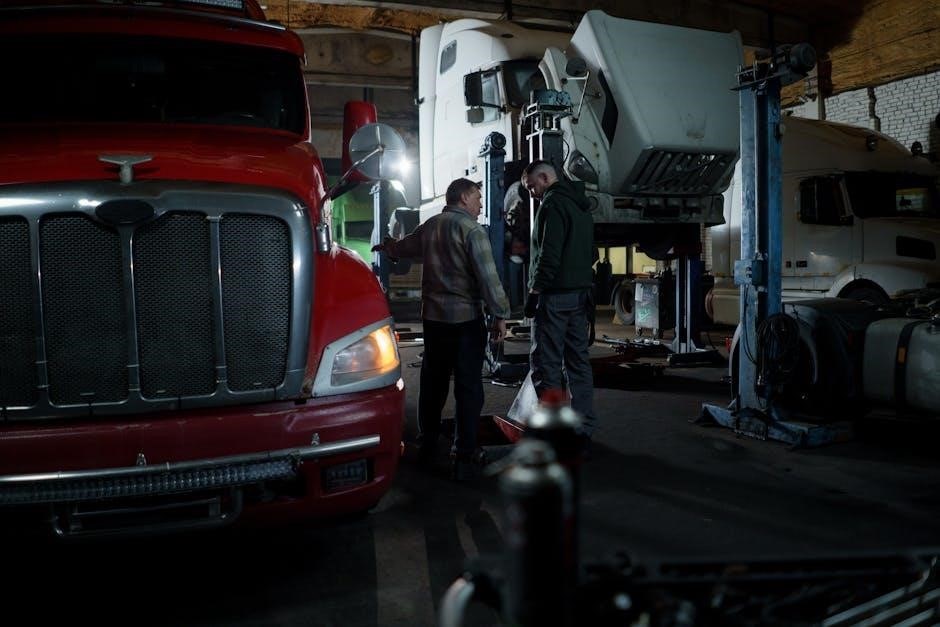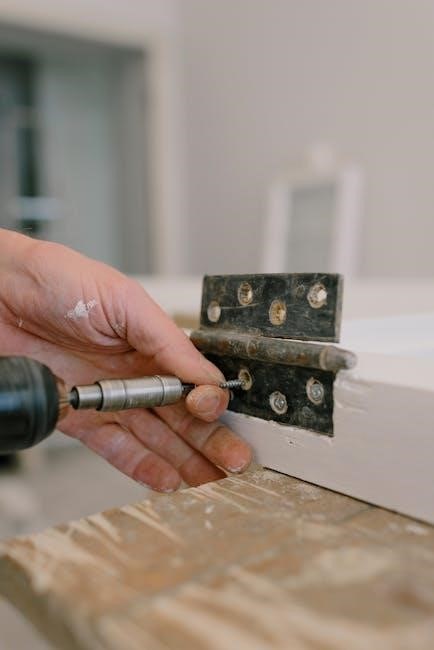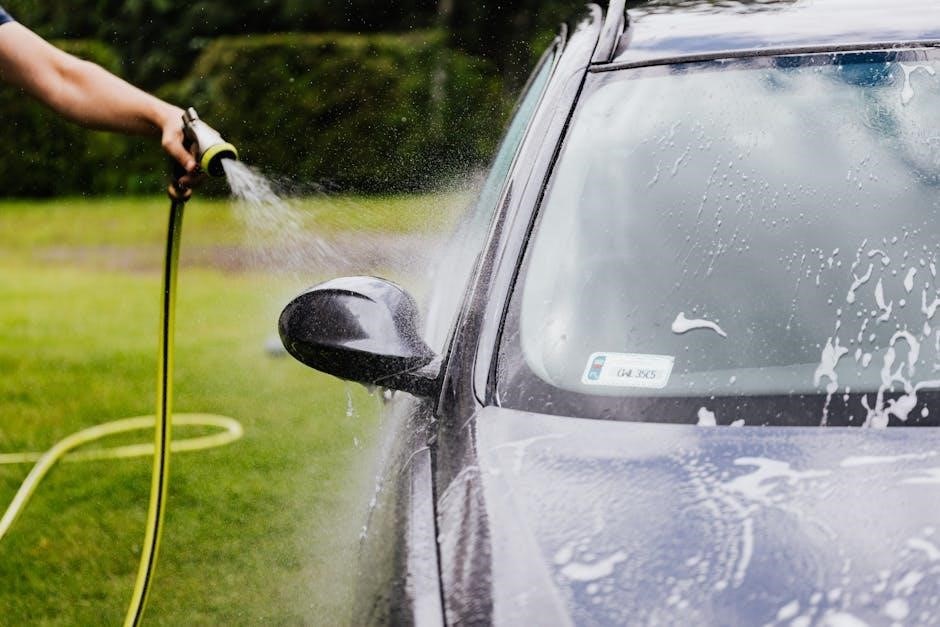The Cessna 150 Maintenance Manual is a comprehensive guide essential for maintaining airworthiness and ensuring safe operation. It provides detailed procedures, inspections, and repair instructions for owners and mechanics.
1.1 Overview of the Manual’s Purpose
The Cessna 150 Maintenance Manual serves as a primary guide for ensuring the safe and efficient operation of the aircraft. It provides detailed procedures for inspections, repairs, and routine maintenance, covering technical specifications, performance, and compliance with regulations. Designed for owners, mechanics, and pilots, the manual offers comprehensive instructions to maintain airworthiness and extend the aircraft’s lifespan. It includes sections on pre-flight checks, lubrication schedules, and advanced repair techniques, ensuring all aspects of upkeep are addressed. The manual is organized for easy navigation, making it an essential tool for professionals and DIY enthusiasts alike.
1.2 Importance of Regular Maintenance
Regular maintenance is crucial for ensuring the Cessna 150 operates safely and efficiently. It prevents mechanical failures, reduces operational risks, and maintains compliance with FAA regulations. By following the manual’s guidelines, owners and mechanics can identify and address issues early, minimizing downtime and extending the aircraft’s lifespan. Proper upkeep also ensures optimal performance, fuel efficiency, and reliability, making regular maintenance an essential investment for both safety and cost-effectiveness. Adhering to the manual’s schedule helps maintain airworthiness and protects the aircraft’s value over time.
1.3 Target Audience: Owners, Mechanics, and Pilots
This manual is designed for Cessna 150 owners, mechanics, and pilots, providing essential guidance for maintenance and operation. Owners will find detailed procedures to ensure their aircraft remains airworthy and safe. Mechanics gain access to technical specifications, inspection checklists, and repair protocols. Pilots benefit from pre-flight and post-flight inspection procedures to ensure readiness for safe flight operations. The manual serves as a shared resource, fostering collaboration and compliance with maintenance standards across all stakeholders.

Technical Specifications and Performance
The Cessna 150 is powered by a Lycoming O-320-E2D engine, delivering 110 horsepower. It features a fixed-pitch propeller, 26-gallon fuel capacity, and a maximum cruise speed of 112 knots.
2.1 Key Features of the Cessna 150 Aircraft
The Cessna 150 is a two-seat, single-engine aircraft known for its simplicity and durability. It features an all-metal cantilever wing design, a fixed tricycle landing gear, and a rearward-sliding canopy. The aircraft is powered by a Lycoming O-320 air-cooled, four-cylinder engine, producing 110 horsepower. Its lightweight construction and efficient design make it an ideal trainer and personal aircraft. The Cessna 150 has a maximum takeoff weight of 1,600 kg and a cruising speed of 112 knots, offering excellent performance for its class.
2.2 Engine and Propeller Specifications
The Cessna 150 is equipped with a Lycoming O-320-E2D air-cooled, four-cylinder engine, delivering 110 horsepower at 2,500 RPM. The engine features a direct-drive system and a dual magneto ignition. The propeller is a fixed-pitch, two-blade McCauley model, designed for optimal performance at various altitudes. The engine’s compact design and reliable operation make it ideal for training and recreational flying. Regular maintenance of the engine and propeller ensures longevity and safety, adhering to the guidelines outlined in the maintenance manual.
2.3 Fuel Capacity and Consumption Rates
The Cessna 150 has a fuel capacity of 26.5 gallons in each of its two wing tanks, totaling 50 gallons. The engine consumes approximately 6 to 7 gallons per hour at normal power settings. Cruising at optimal altitudes, the aircraft achieves a fuel efficiency of about 500 nautical miles. Proper fuel management is essential to ensure safe and efficient operation. Always use 100LL avgas to maintain engine performance and longevity. Regular fuel system inspections are critical to prevent contamination and ensure reliable operation.

Routine Maintenance Procedures
Routine maintenance ensures the Cessna 150 operates safely and efficiently. This includes daily pre-flight checks, weekly lubrication, and monthly inspections of spark plugs and air filters.
3.1 Daily Pre-Flight Checks
Daily pre-flight checks are essential for ensuring the Cessna 150’s airworthiness. Inspect control surfaces, tires, and brakes for damage or wear. Check oil and fuel levels, ensuring no contaminants are present. Verify propeller condition, looking for nicks or cracks. Inside the cockpit, test all instruments, switches, and controls for proper function. Ensure seat belts and harnesses are secure. Review weather conditions and navigation equipment. Always consult the Pilot’s Operating Handbook (POH) for specific procedures to guarantee safety and compliance with maintenance standards.
3.2 Weekly Lubrication and Fluid Checks
Weekly lubrication and fluid checks are critical for maintaining the Cessna 150’s performance. Inspect engine oil levels, ensuring proper viscosity, and check hydraulic fluid for leaks or contamination. Lubricate hinge points, pulleys, and other moving parts with approved greases. Verify coolant levels and condition if applicable. Examine the propeller for proper lubrication and tighten bolts as needed. Always follow the recommended schedule in the maintenance manual to prevent wear and ensure smooth operation. Regular checks help prevent costly repairs and extend aircraft lifespan.
3.3 Monthly Inspection Requirements
The monthly inspection for the Cessna 150 involves a detailed examination of critical systems. Inspect control surfaces for damage or play, and check tires for wear and proper inflation. Test brake functionality and examine landing gear components for damage. Verify battery health, ignition system operation, and air filter condition. Ensure all lights and navigation equipment are functioning. Review the aircraft’s logbooks to confirm compliance with maintenance schedules. Address any discrepancies immediately to maintain airworthiness and safety. Document all findings in the maintenance records.

Detailed Inspection Processes
Detailed inspections ensure the aircraft’s safety and reliability by thoroughly examining systems at specific intervals, involving expert mechanics to identify and address potential issues proactively.
4.1 Annual Inspection Checklist
The annual inspection checklist for the Cessna 150 is a comprehensive review of the aircraft’s systems and components. Mechanics inspect the engine, propeller, avionics, and electrical systems for wear or damage. Fuel systems, control surfaces, and landing gear are also examined. Corrosion checks and compliance with airworthiness directives are prioritized. This detailed process ensures the aircraft meets safety and regulatory standards, addressing any issues before they become critical. Regular adherence to this checklist is essential for maintaining reliability and extending the aircraft’s operational lifespan.
4.2 100-Hour Inspection Requirements
The 100-hour inspection is a detailed examination of the Cessna 150, mandated for aircraft used in commercial operations or flight training. It includes a thorough check of the engine, propeller, and avionics systems. Mechanics inspect control surfaces, landing gear, and fuel systems for wear or damage. Additionally, electrical and hydraulic systems are tested for proper function. This inspection ensures compliance with FAA regulations and maintains the aircraft’s airworthiness. It is typically performed alongside the annual inspection for consistency and safety, addressing any issues before they escalate into major problems.
4.3 Special Inspections for High-Usage Aircraft
High-usage Cessna 150 aircraft require additional inspections to ensure longevity and safety. These aircraft, often used in flight training, undergo more frequent stress. Inspectors focus on critical components like engine mounts, control surfaces, and landing gear. Environmental factors, such as moisture exposure, are also evaluated for corrosion risks. Electrical and avionics systems are tested for reliability, and hydraulic lines are checked for leaks. These inspections are tailored to address wear patterns specific to high operational demands, ensuring the aircraft remains airworthy and operationally efficient over time.

Repair and Replacement Guidelines
This section outlines procedures for repairing or replacing damaged components, ensuring compliance with manufacturer specifications and airworthiness standards. It emphasizes proper documentation of all repairs.
5.1 Engine Overhaul Procedures
Engine overhaul for the Cessna 150 involves disassembling, inspecting, and replacing worn components. Follow manufacturer guidelines for piston, cylinder, and crankcase replacements. Ensure all parts meet FAA standards. Reassembly requires precise torque specifications and clearance checks. Conduct a test run post-overhaul to verify performance. Document all work for maintenance records. Always refer to the official manual for detailed procedures and safety precautions to maintain airworthiness and reliability.
5.2 Propeller Maintenance and Replacement
Regular propeller maintenance involves inspecting blades for damage, nicks, or erosion. Check hub bolts for tightness and ensure proper pitch setting. Perform static rpm tests to verify operation. Replacement is required if damage exceeds repair limits or after 2,400 hours of operation. Always use FAA-approved replacement parts. Follow manufacturer guidelines for hub disassembly and reassembly. Document all maintenance activities for compliance. Ensure propeller balance and alignment post-installation for optimal performance and safety.
5.3 Avionics and Electrical System Repairs
Avionics and electrical system repairs require meticulous attention to detail to ensure proper aircraft functionality. Start by troubleshooting issues using diagnostic tools and manuals. Replace faulty components like navigation instruments or communication radios with FAA-approved parts. Calibrate systems to manufacturer specifications. Test all functions post-repair to confirm reliability. Use wiring diagrams to trace and repair electrical faults. Document all repairs and testing results for compliance. Regular updates to avionics software may be necessary for optimal performance. Always follow safety protocols when handling electrical systems to prevent damage or injury.
Parts Catalog and Ordering Information
The Cessna 150 parts catalog lists all required components with part numbers and descriptions. Order parts through authorized suppliers or Cessna’s online portal. Verify part numbers before purchasing to ensure accuracy and compliance.
6.1 Approved Parts and Suppliers
Only use parts approved by the FAA or Cessna for the 150 series. Approved suppliers include Cessna-authorized distributors and certified aviation parts manufacturers. Ensure parts meet original specifications and airworthiness standards. Verify supplier certifications and part authenticity to avoid counterfeit components. Consult the official parts catalog for valid part numbers and descriptions. Avoid unauthorized third-party sellers unless verified. Always cross-reference parts with the Cessna 150 maintenance manual for compliance and safety.
6.2 Ordering Replacement Parts
To order replacement parts for the Cessna 150, contact approved suppliers or Cessna-authorized distributors. Always use the correct part numbers from the official parts catalog. Online ordering systems may be available through Cessna’s service portal. Ensure to verify lead times and shipping options. For international orders, check customs and import regulations. Return policies vary by supplier, so review terms before purchasing. Keep records of orders for warranty and compliance purposes. Timely ordering ensures maintenance schedules are met without delays.
6.3 Warranty and Return Policies
Replacement parts for the Cessna 150 are typically covered by a limited warranty, usually spanning 12 to 24 months or a specified number of flight hours. Warranties may vary depending on the supplier and part type. Returns must be pre-approved and accompanied by proof of purchase and a detailed defect description. Non-defective returns may incur restocking fees. Warranty claims require submission of maintenance records. Always review the supplier’s terms before initiating a return. Compliance with these policies ensures smooth processing and maintains warranty validity.

Tools and Equipment Required
Basic hand tools, wrenches, screwdrivers, and specialized equipment like torque wrenches are essential. Safety gear, including gloves and safety glasses, is mandatory for all maintenance tasks.
7.1 Essential Tools for Routine Maintenance
For routine maintenance, essential tools include wrenches, pliers, screwdrivers, and hammers. A multimeter, air pressure gauge, and tire pressure gauge are crucial for system checks. A spark plug gap gauge ensures proper engine ignition. Safety equipment like gloves and safety glasses is mandatory. A drain pan and drip trays prevent fluid spills. A torque wrench is needed for bolt tightening. Basic hand tools, such as punches and chisels, aid in inspections. These tools ensure compliance with manual procedures and safety standards for the Cessna 150 aircraft.
7.2 Specialized Tools for Complex Repairs
Specialized tools are required for complex repairs on the Cessna 150. These include a piston ring compressor for engine overhauls, a propeller puller for hub maintenance, and a timing light for engine ignition diagnostics. A nav radio alignment tool ensures proper avionics calibration. A fuel flow test kit verifies fuel system performance, while a hydraulic pressure test kit checks for system leaks. A circuit tester with a lamp aids in diagnosing electrical issues. These tools are essential for addressing intricate repairs beyond routine maintenance, ensuring precise and safe aircraft restoration.
7.3 Safety Equipment for Mechanics
Safety equipment is crucial for mechanics working on the Cessna 150. Essential items include gloves, safety glasses, and a face mask to protect against chemicals and debris. A fire extinguisher should always be nearby when handling flammable materials. Proper ventilation is necessary when working with fuels or paints. Steel-toe boots and high-visibility vests are recommended for workshop safety. Hearing protection is vital when operating power tools. A first aid kit and eyewash station should be accessible. Fall protection gear, like harnesses, is needed for elevated tasks. Safety equipment ensures a secure working environment for mechanics.

Troubleshooting Common Issues
This section provides guidance for identifying and resolving common mechanical and electrical issues in the Cessna 150, ensuring safe and effective problem-solving during maintenance.
8.1 Diagnosing Engine Problems
Diagnosing engine issues in the Cessna 150 involves checking for common symptoms like rough running, low power, or excessive oil consumption. Start by inspecting the air filter, spark plugs, and fuel system for blockages or contamination. Listen for unusual noises, such as knocking or grinding, which may indicate piston or valve problems. Use compression tests and magneto checks to identify cylinder performance issues. Always refer to the manual for specific troubleshooting procedures and consult a certified mechanic if problems persist. Regular maintenance can often prevent these issues from arising.
8.2 Resolving Electrical System Malfunctions
Resolving electrical system malfunctions in the Cessna 150 begins with identifying symptoms like dimming lights, faulty avionics, or circuit breaker tripping. Check the circuit breakers and reset them if necessary. Inspect wiring and connections for damage or corrosion. Test the alternator and battery using a multimeter to ensure proper voltage and charge. Replace faulty components and ensure all electrical systems are grounded correctly. Refer to the manual for specific troubleshooting steps and consult a certified avionics technician if issues persist. Regular inspection of electrical systems can prevent malfunctions during flight.
8.3 Addressing Hydraulic System Leaks
Addressing hydraulic system leaks in the Cessna 150 involves identifying the source and severity of the leak. Inspect hoses, fittings, and cylinders for visible signs of hydraulic fluid. Pressure-test the system to locate the leak’s origin. Replace any damaged or worn components, ensuring proper sealing. Use approved hydraulic fluid and torque specifications from the manual. Always ground the aircraft during repairs and consult a certified mechanic if unsure. Regular inspection of hydraulic lines and connections can prevent leaks and ensure safe operation.

Compliance and Regulatory Requirements
Compliance with aviation authority regulations is essential for the Cessna 150. Adhere to airworthiness directives, maintain proper documentation, and ensure all maintenance meets federal guidelines. Regular inspections and updates guarantee safety and legal operation.
9.1 FAA Regulations for Maintenance
The Cessna 150 must comply with Federal Aviation Administration (FAA) regulations to ensure airworthiness and safety. Maintenance activities must follow FAA-approved procedures outlined in the maintenance manual. All inspections, repairs, and modifications must adhere to FAR (Federal Aviation Regulations) Part 43 guidelines. Proper documentation of maintenance activities is mandatory, including records of inspections, repairs, and parts replacements. The FAA also requires that only certified mechanics perform specific maintenance tasks. Non-compliance can result in legal penalties and loss of airworthiness certification. Regular audits and inspections by FAA representatives ensure adherence to these regulations. Compliance is critical for safe operation and legal flight status.
9.2 Record-Keeping and Documentation
Accurate and detailed record-keeping is essential for maintaining the Cessna 150’s airworthiness. All maintenance activities must be documented in the aircraft’s maintenance logs, including dates, procedures performed, and personnel involved. Inspection checklists, work orders, and parts replaced must be recorded. Documentation must comply with FAA guidelines and be signed by certified mechanics. Records should be stored securely to prevent loss or damage. Proper documentation ensures traceability of maintenance history and compliance with regulatory requirements. Incomplete or missing records can lead to legal issues and loss of airworthiness certification.
9.4 Compliance with Airworthiness Directives
Compliance with airworthiness directives (ADs) is critical for ensuring the Cessna 150 remains safe and compliant with aviation regulations. ADs are mandatory instructions issued by the FAA to address specific safety concerns or issues. Owners and mechanics must identify and apply all relevant ADs to the aircraft. This includes inspections, modifications, or repairs as specified. ADs can be found in the Federal Register or on the FAA website. Non-compliance can result in the aircraft being deemed unairworthy. Adherence to ADs is legally required and essential for maintaining safety and regulatory compliance.

Safety Precautions and Best Practices
Adhering to safety protocols is essential during Cessna 150 maintenance. Always wear personal protective equipment and ensure proper handling of hazardous materials. Follow manuals, use tools correctly, and prepare for emergencies.
10.1 Personal Protective Equipment (PPE)
Wearing appropriate Personal Protective Equipment (PPE) is crucial during Cessna 150 maintenance. This includes safety glasses, gloves, and steel-toe boots to prevent injuries from tools or sharp edges. Mechanics should also use high-visibility vests for visibility in busy hangars. Respirators may be necessary when handling chemicals or paints. Ensuring PPE is worn correctly minimizes risks and prevents accidents. Always inspect PPE for damage before use. Remember, safety should never be compromised during aircraft maintenance procedures.
10.2 Safe Handling of Hazardous Materials
Proper handling of hazardous materials is essential during Cessna 150 maintenance. Always store chemicals, fuels, and cleaning agents in approved containers with clear labels. Ensure storage areas are well-ventilated and away from ignition sources. Use protective gloves and eyewear when handling corrosive or toxic substances. Follow manufacturer instructions for application and disposal. Spill kits should be readily available to contain and clean up accidents. Dispose of hazardous waste in accordance with local environmental regulations to prevent contamination. Proper training ensures safe handling and compliance with safety standards.
10.3 Emergency Procedures During Maintenance
Emergency procedures during Cessna 150 maintenance are critical for ensuring safety. Identify potential hazards and have a plan in place. Keep fire extinguishers and first aid kits accessible. Familiarize yourself with emergency exits and communication devices. In case of a fire, evacuate the area and use appropriate extinguishers. For injuries, administer basic first aid and seek medical help immediately. Spills of hazardous materials should be contained and cleaned up promptly. Regular drills ensure preparedness. Always follow established protocols to minimize risks and ensure a swift response to emergencies.

Extending the Aircraft’s Lifespan
Regular maintenance, corrosion protection, and proper storage are key to extending the Cessna 150’s lifespan. Adhering to scheduled inspections and addressing wear promptly ensures longevity and safety.
11.1 Preventative Maintenance Strategies
Preventative maintenance is crucial for extending the Cessna 150’s lifespan. Regular oil changes, lubrication of moving parts, and inspection of wear-prone components like tires and brakes help prevent premature damage. Adhering to the manufacturer’s recommended maintenance schedule ensures that potential issues are identified early, reducing the risk of costly repairs. Additionally, routine cleaning of the aircraft’s exterior and interior prevents corrosion and degradation. By prioritizing preventative care, owners can significantly extend the aircraft’s operational life while maintaining safety and performance standards.
11.2 Protecting Against Corrosion
Protecting the Cessna 150 from corrosion is essential for its longevity. Regularly inspect areas prone to moisture, such as wing spars, fuselage joints, and control surfaces. Clean and remove dirt or debris that can trap water. Apply corrosion-resistant coatings to metal surfaces and treat aluminum parts with approved inhibitors. Ensure drainage holes are clear to prevent water accumulation. Store the aircraft in a dry environment when not in use, and consider using desiccant bags to reduce humidity. Addressing corrosion early prevents structural damage and maintains airworthiness.
11.3 Optimizing Fuel Efficiency
Optimizing fuel efficiency in the Cessna 150 involves regular maintenance and smart flying practices. Ensure the air filter is clean and the fuel system is free of leaks or contamination. Fly at optimal altitudes and maintain recommended cruise speeds to reduce fuel consumption. Properly manage aircraft weight to avoid unnecessary drag. Monitor fuel flow during flight and adjust power settings as needed. Plan routes to minimize wind resistance and avoid excessive climbs. Regularly review flight data to identify efficiency improvements. Adhering to these practices can significantly extend fuel range and lower operating costs.